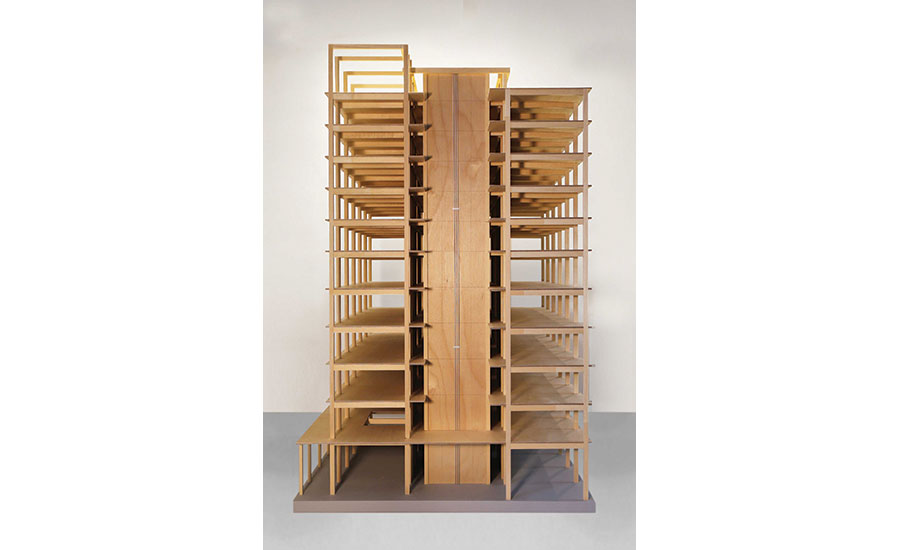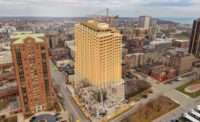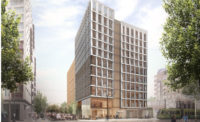 Thomas F. Robinson
Thomas F. Robinson
Portland, Ore.
ENR 10/24/16 p. 24
Architect is supporting a forest-to-frame movement in the Northwest by spearheading a 148-ft-tall mass-timber building project.
Thomas Robinson never designed a wood-framed building of any significant size until after he moved to earthquake-prone Portland, Ore., in 2003. Currently, he is working on his third and largest—the 90,000-sq-ft mass-timber Framework.
“Our commitment to building with mass timber emerges from an interest in the potential of material innovation to create great architecture that is beautiful, economical and sustainable,” says the 48-year-old Robinson, founding principal of Lever Architecture, formed in 2009.
With Framework, it is much more than square footage that matters. At 148 ft, the multiuse building, designed for a site in Portland, is on deck to be the tallest mass-timber building in the U.S. It is also on course to be the only building with a timber “rocking-wall” core. The vertically post-tensioned system minimizes quake damage by swaying in a temblor and then returning to a plumb position. When completed next year, the 130-ft rocking wall will be the world’s tallest.
“Thomas has continually driven us to innovate and to push the envelope technically … within the bounds of a very tight project budget,” says David Barber, a principal with Framework’s fire protection engineer, Arup.
Constructing a 12-story mass-timber frame—even one with an innovative seismic design—is not as difficult as getting approvals from the authorities with jurisdiction. U.S. building officials, suspicious of timber’s fire resistance, limit timber frames to four or five stories.
To assuage building officials’ fears, the Framework team had to demonstrate, through performance-based design and component testing, that the structure—particularly the steel column-to-beam connections—could withstand a two-hour fire without the aid of sprinklers.
To smooth the path toward approval, Robinson approached building officials at the very start of the project. “Performance-based design is a much more involved process, as it almost always requires an independent peer review, extensive computer modeling of seismic and fire designs, and large-scale component testing,” says Robinson. “We have all of these in Framework.”
Building authorities at the state and city levels are behind the project. “We have received design-review approval from the city of Portland as part of the land-use review process,” says Robinson. The state authority that issues building permits is currently reviewing the completed set of drawings. Robinson expects a green light within weeks. If all goes as planned, work will begin in March and take 13 months.
The permit application relies on first-of-a-kind fire tests, which demonstrated that properly designed and detailed structural mass timber can achieve a two-hour fire rating—equivalent to the rating of steel or concrete. The tests were funded by a $1.5-million design-competition prize from the U.S. Dept. of Agriculture, in partnership with the Softwood Lumber Board and the Binational Softwood Lumber Council.
Before the tests, there had been only five fire tests outside the U.S. in which specimens achieved a one-hour rating; none achieved a 1.5-hour rating. In early talks, “Thomas didn’t really believe me that no one had even come close to two hours, so I sent him a table of fire-test results,” says Barber.
Soon after, Robinson asked whether a two-hour rating was technically feasible. Barber’s answer was “yes, but it could all end in tears.” According to Barber, Robinson replied, “That is exactly the type of problem we should be trying to solve.”
The architect’s interest in wood dates to his youth. Family trips exposed him to an all-wood Cape Cod cabin, built in 1928 by his paternal great-grandfather, and a 1785 wood house in Germany, renovated by his maternal grandfather. “Those special places had a lasting effect on me,” he says.
Robinson is taking wood framing beyond the single project by nurturing a fledgling forest-to-frame movement in the Northwest, which, like the farm-to-table movement for restaurant food, is trying to strengthen the local supply chain for the renewable material, especially for cross-laminated timber.
“Thomas Robinson understands the broad, concerted effort required to realize and implement the adoption of mass timber in the U.S.,” says Anyeley Hallová, a partner with Project^, Framework’s developer. “His vision not only signifies a new chapter in the use of sustainable building materials but also one that promotes job creation and a viable new economy through the interplay of rural and urban economies.”






Post a comment to this article
Report Abusive Comment